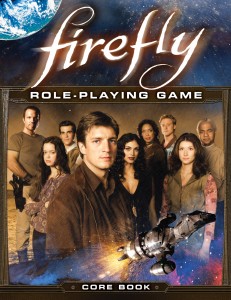GMs have always been an important part of our design philosophy on the Firefly RPG line, and Margaret in particular wanted to make sure that we had enough support for them. There is a difference between a narrative-based system and a more traditional one with a damage track and XP points. One of the nuances that can be hard for players to wrap their minds around, is that Cortex Plus is player-driven, where the players are in charge and drive the story.
How can a GM do this and direct an Episode? When I was designing the Episode structure, I mapped it to the beats of the story presented in the Firefly TV show. (This was a skill I had picked up from the writing, reading, and playing I did for White Wolf. In the Storyteller Adventure System (SAS), there are scenes the GM can run and a number of different paths those scenes can take.) In Firefly, I wanted to give GMs a jumping off point, where we present a possibility of how the story might break down based on what players might do. In general, we felt that players would probably be familiar with the feel of a Firefly TV show; the breakdown of the structure is something GMs can use to reinforce Whedon’s powerful characterizations.
There is, however, a problem that can occur in a game that’s reliant on player agency. Sometimes, GMs might encounter a certain amount of decision paralysis or “sit and wait for the GM to throw something else my way.” That can be tough, especially for GMs who want to run a narrative-based game where pacing is crucial. I resolve this particular issue, decision paralysis, in a number of different ways. There are some things I do at the table that goes beyond framing my scenes hard and saying: “Cut to Commercial!”
Here’s a few of my techniques:
-
1) I shoot at them. A bullet whizzes past your ear. Oh no! What are you going to do now? My reasoning behind this is that firefights can and do happen often in Firefly. When a player is shot at, that often prompts the rest of the Crew to help out.
2) I prompt them. You’re talking to Badger and he’s given you an ultimatum: pay up or hand over one of your Crewmembers. Right now. Don’t know what to do? Have you asked your Captain for advice? Okay, that didn’t pan out. You might want to… And then I give three or four options the Crewmember can cue off of. I’ve never had a player take my exact advice, but uses that as a way to think about what to do next.
3) I use Timed Actions. One of our favorite techniques to influence pacing is to utilized Timed Actions to reflect the pressure in any given situation. The other benefit of Timed Actions, however, is that it prompts teamwork! Each player has a role to take in the Action Order, and they often discuss how to get through that scenario as a team. Works like a charm!
4) I create an Asset/Complication for that Crewmember. Sometimes, Crewmembers need a little help and the best way, I’ve found, is to use the system to do that. A free Asset is something I offer in times of dire need, and it can take the edge off of bad luck. Complications that prompt a character to act, rather than hinder that character, are crucial here. Badly-worded Complications can impact the mood of a game very easily, and it’s a place I’d recommend all GMs either improve upon or collaborate with players.
5) I walk away from the table. I feel that without good synergy at the table, players can get stuck because they’re focused on what they want/need to be doing because they’re worried about the group. When I do this, I plan for a crucial moment. Explain what that moment is, then tell the group: “When I come back, decide on a course of action.” That takes the pressure off that player, and encourages them to work together.
6) I hand out Plot Points. At the beginning of Act I (and so on), I ask players for a recap of the previous scene and hand out Plot Points to the player who summarizes it. I sometimes ask players to recap their favorite moment of the previous act provided they can recommend what someone else did. That, sometimes, adds interesting flavor to the table because a player might not think they’re doing a good job–until someone else says they are.
Hope that jumpstarts your brainpan for this particular issue! Happy gaming!

